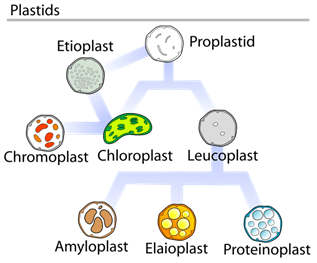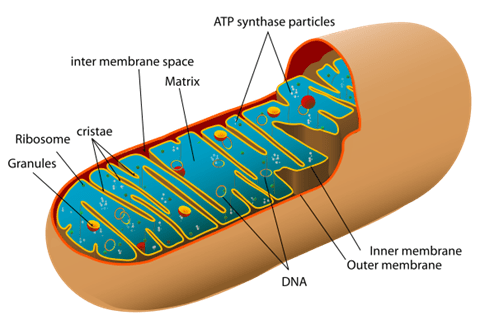Difference Between Mitochondria and Plastids
Mitochondria vs Plastids
Mitochondria (singular – mitochondrion) and plastids are two important membrane bound organelles located inside the eukaryotic cells (cells that contain organized nucleus). Mitochondrion is the place where cell utilizes sugar molecules to produce high energy containing molecules called adenosine triphosphate (ATP), and the process is called respiration. Plastids are involved in energy production by absorption of sunlight to their green color pigment chlorophyll and convert them into sugars, and the process is called photosynthesis. Both these organelles have their own DNA and small (70s) ribosomes. Therefore, scientists believe that mitochondria and plastids were originated 1.5-1.6billions years ago via an event called endosymbiosis. That is prokaryotic cell (cells which do not have organized nucleus) engulfs a photosynthetic bacterium and retains it inside the cell. However, these plastids do not occur in animal, fungi or prokaryotic cells.
Plastids
Plastids initially occur in the cells, in their undifferentiated form named as proplastids. Depending on the tissue, they are differentiated into different types such as Chloroplasts, amyloplasts, chromoplasts, or leucoplasts. Chloroplasts are the most abundant type of plastid and are found in all green parts of the plants and algae. Amyloplasts are another type of plastids which store polymerized sugars (starch) as granules. These are found in non-photosynthetic tissues like roots, bark, and wood. There is another type of plastids called chromoplasts which gives colors to various tissues. The color is produced as a result of accumulation of different colored lipids inside the plastids. As an example bright red color in apples, orange color in oranges etc. Also, there are colorless plastids in the cytoplasm. They can be either proplastids or amyloplasts. Therefore, all these colorless plastids are called leucoplasts.
Mitochondria
Cells store energy as the form of starch or sugars. When cells need energy they convert these molecules into ATP inside the mitochondria. Mitochondria have two membranes called outer membrane and inner membrane. Outer membrane gives the shape and rigidity to the organelle. Inner membrane is highly folded structure that produce sheets or tubes called cristae (singular, crista). Many enzymes needed for the respiration are located inside cristae. Liquid in between cristae is called matrix.
What is the difference between Mitochondria and Plastids?
There are some differences in these two organelles;
• Plastids occur only in plant and algae cells, but mitochondria are found in all eukaryotic cells.
• Mitochondria are smaller than chloroplasts: Mitochondrion is about 1μm in diameter and up to 5μm in length, whereas, chloroplast is 4-6 μm in diameter.
• Main function of mitochondria is the cell respiration, but plastids involve in many functions such as production of sugar and temporarily store them as starch, storage of starch and lipids.
• Number of mitochondria per cell is greater than that of the number of chloroplasts. That is mitochondria per cell are usually 100-10,000, whereas chloroplasts per plant cell are about 50.
• Both can produce their own copies by division.
Read more:
1. Difference Between Mitochondrial DNA and Nuclear DNA
ncG1vNJzZmivp6x7pbXFn5yrnZ6YsqOx07CcnqZemLyue8OinZ%2Bdopq7pLGMm5ytr5Wau265yK2mnKCfo7GztcBmmKecXaW5or%2FTopusZw%3D%3D

